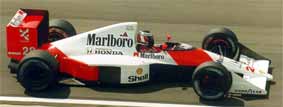McLaren MP4-5B

Active: 1990
Team: McLaren International Ltd
Team: Neil Oatley
Drivers: Ayrton Senna (27), Gerhard Berger (28)
With World Champion Alain Prost and Steve Nichols departing for Ferrari, thus cementing the Italian team’s 1990 status as McLaren's strongest challenger, and Gordon Murray turning his attention to the McLaren F1 road car project. Neil Oatley and his design colleagues opted to refine the MP4/5 for Ayrton Senna and his incoming new team-mate Gerhard Berger rather than create an entirely new car.
The latter would probably have wished otherwise since he was too tall to fit into the car comfortably when he first tested it. It was otherwise clearly a winner, however, and while it was true that McLaren’s principal challengers, Ferrari and Williams, were catching up, the opinion at Woking was that the existing car was a good basis on which to continue.
Honda produced a new derivative of its V10, the RA1O0E engine. The car's monocoque was broadly similar, however, but used a new high-modulus material from Hercules Corporation which promised even greater impact resistance. A new, slightly larger fuel cell was also installed, whilst the suspension geometry was altered at the front and the transverse gearbox substantially revised.
While the car still looked broadly similar, some evolutionary rather than radical revisions were also made to its aerodynamic profile with particular reference to the sidepods and radiator ducting. It also gained a new windscreen design and a distinctive multi-arched diffuser. That diffuser was superseded by mid-season, by which time Berger's seating position problems had finally been resolved by making his driving position slightly more upright than Senna’s.
It was to be a busy time at McLaren. While one crew was designing and building MP4/5B race cars, work was starting in parallel on a MP4/5C test car to accommodate a new V12 Honda engine intended for the following season. The fact that the very first ‘B’ car then sustained some serious damage in Senna‘s hands didn’t help matters, although the incident during pre-season shakedown trials at Silverstone provided some useful evidence to support the driver’s assertion that the new chassis was rather more responsive than the MP4/5.
The season itself got off to a good start, however with Senna quickly negating Berger's pole in the Phoenix opener and blasting his way to victory after a brief battle with the forceful Jean Alesi’s Tyrrell. Thereafter he took pole position 10 times, but it was nevertheless obvious from the moment the new cars were completed that the team faced a greater challenge than it had in 1989. Not just from Prost at Ferrari (where he was partnered by Nigel Mansell), but also from Williams where Thierry Boutsen and Riccardo Patrese were making their presence felt with Renault V10 power in the FW13B.
None of this seemed to worry Senna, who led every race of the season except Hungary, where he was forced to chase Boutsen‘s Williams all the way to the finish, and Suzuka, where he cynically took out former team-mate Prost‘s Ferrari to claim a controversial second World Championship.
Over the course of the season the car improved significantly - helped in no small part by a new underbody which made it both easier to control and more comfortable to drive.
Mike Gascoyne, one of the team's wind tunnel aerodynamicists who would later become a renowned designer, said later in 2020 that he had used a photo of the 1989 Leyton House car after it got involved in a crash at the French Grand Prix: "I used the photo of the upside down Leyton House to copy the diffuser design which was the diffuser used on the world championship winning McLaren MP4/5B"
The responsibility for this upturn, and in particular for Senna‘s car, now fell to American Gordon Kimball, as Oatley moved on to design the V12-engined MP4/6 for 1991.
Honda too continued the development of its engine package, so that Senna’s V10 was at times producing around 710bhp thanks to increased rev limits and new, lower density fuel which he used in qualifying. At Hockenheim Osamu Goto and his team unboxed a slightly lighter Version 4 power unit, with Version 5 coming along in time for Spa-Francorchamps and producing even better top-end results.
Eventually, the car was good for 12 pole positions that season, leading up into the team's third consecutive Constructors' World Championship title, along with the Drivers' World Championship in Senna's bag.
Sources: McLaren Racing, Mike Gascoyne